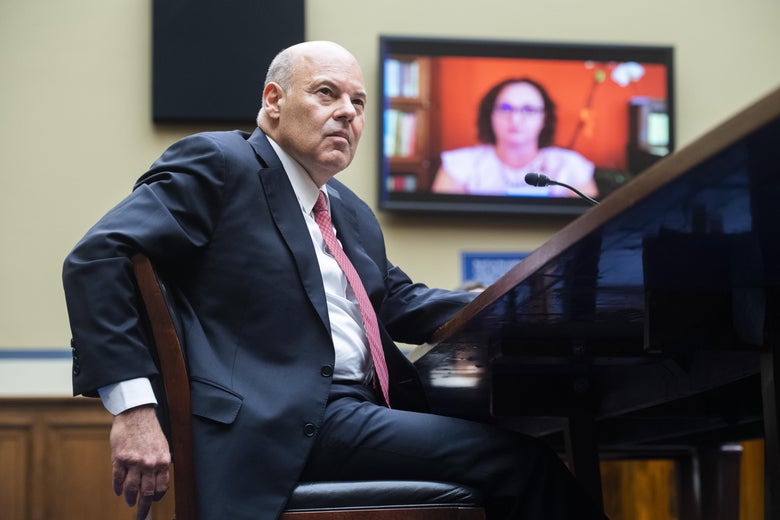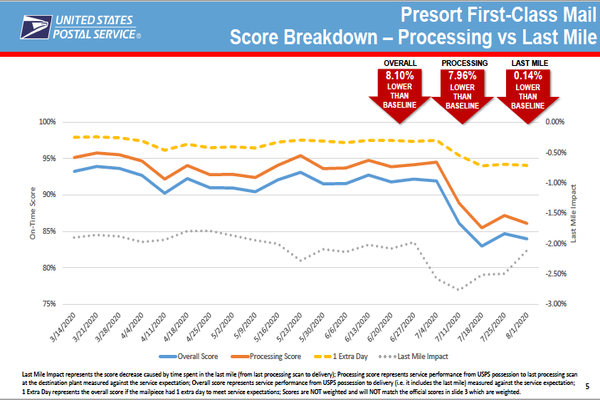
The House Oversight Committee got its chance to grill Postmaster General Louis DeJoy on Monday about his decisions that have bogged down mail delivery and created widespread panic about the upcoming election. While most of the hearing was only faintly illuminating (members spent much of their time rehashing lines of questioning that the Senate covered in its own session Friday, but with more shouting), it did yield at least one important new piece of information, besides the fact that USPS’ boss has no idea how much it costs to mail a postcard: We now know, more or less, how much DeJoy actually slowed the mail down across the country.
According to an internal USPS report that Democrats presented during the hearing, the on-time delivery rate for first-class mail fell by about 8.1 percent between the middle of July and beginning of August. That’s just about when DeJoy implemented a controversial new policy that required postal truck drivers to start their routes on schedule and leave mail behind at processing plants if the sorting process ran late, which he’s admitted led to delays as packages and letters got stranded on loading docks. By the start of this month, it looks like about 84 percent of first-class deliveries were actually landing in America’s mailboxes on time. (Unfortunately, we have to eye-ball from the graph, because the presentation didn’t include hard numbers, other than the ones you see in those arrows.)

But while the delays are real, for the most par they don’t appear to be that lengthy. Just under 95 percent of first-class mail is still either arriving on-time or is no more than a day behind schedule. (See the yellow line.) DeJoy has told Congress that any mail that gets left behind in a processing plant overnight is supposed to be picked up and moved along the next day; these figures suggest he’s not totally full of it. They also line up with reports from analytics firms like GrayHair Software and SnailWorks, which track mail for their corporate clients, and have said it’s taking an extra day or two for deliveries, on average.
How do we square this data with the widespread stories about Americans waiting a week or longer for important deliveries like prescription medications? One answer might be that these are national averages, and the delays are probably more severe in some parts of the country than others; USPS data published as part of an industry presentation show that mail is more likely to run late in the agency’s Eastern region than the Pacific, for instance. Another explanation could be that the figures House Dems unveiled Friday don’t cover package delivery, which in some regions appears to have been backlogged thanks to the massive amount of online shopping Americans have done during the coronavirus crisis. If you’re waiting on a shipment of heart meds or insulin, USPS’s package issues are likely at play. That said, some major mail order-pharmacists like CVS and Express Scripts have said they aren’t noticing any significant problems with their shipping, which suggests some of the wrenching anecdotes making it into news stories might not be that typical.
While the Postal Service’s delays may not be that severe, that doesn’t mean we can sleep easy over how they might affect the election. No matter how hard candidates or local party officials try to get voters to request and send in their ballots early, chances are many Americans will still try to do it at the last minute. And even if only a small percentage of ballots arrive too late to be counted, it could be enough to tip the balance in a tight swing state or in a crucial Senate race, especially once you add in the ballots that will inevitably be voided because of signature mismatch, missing witness statements, the lack of a postmark, and other common problems. During his two days of testimony, DeJoy has promised that he’s working to fix the slowdown he created, and will do whatever’s necessary to deliver ballots on time for the election. But there’s still enough smoke—emanating from DeJoy’s strange hiring to some other aspects of USPS’ business of late—that for now it’s probably healthy to be a little wary and paranoid. If you do request a ballot at the last minute, consider driving it to your local drop box.
"much" - Google News
August 25, 2020 at 07:47AM
https://ift.tt/3gsoa1c
We Now Know How Much Trump’s Postmaster General Slowed Down the Mail - Slate
"much" - Google News
https://ift.tt/37eLLij
Shoes Man Tutorial
Pos News Update
Meme Update
Korean Entertainment News
Japan News Update
Bagikan Berita Ini















0 Response to "We Now Know How Much Trump’s Postmaster General Slowed Down the Mail - Slate"
Post a Comment